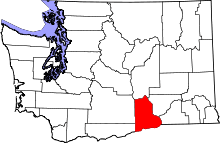Richland, Washington
| Richland, Washington | |
|---|---|
| City | |
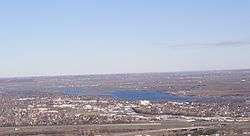 | |
| Nickname(s): The Windy City, Home Of the Bombers | |
 Location of Richland, Washington | |
| Coordinates: 46°16′47″N 119°16′53″W / 46.27972°N 119.28139°W | |
| Country | United States |
| State | Washington |
| County | Benton |
| Government | |
| • Type | Council–manager government |
| • Mayor | David W. Rose |
| • Mayor Pro Tem | Phillip Lemley |
| Area[1] | |
| • City | 39.11 sq mi (101.29 km2) |
| • Land | 35.72 sq mi (92.51 km2) |
| • Water | 3.39 sq mi (8.78 km2) |
| Elevation | 384 ft (117 m) |
| Population (2010)[2] | |
| • City | 48,058 |
| • Estimate (2015)[3] | 54,248 |
| • Rank | US: 692nd |
| • Density | 1,345.4/sq mi (519.5/km2) |
| • Metro | 279,116 (US: 169th) |
| Time zone | Pacific (PST) (UTC-8) |
| • Summer (DST) | PDT (UTC-7) |
| ZIP codes | 99352, 99353, 99354 |
| Area code(s) | 509 |
| FIPS code | 53-58235 |
| GNIS feature ID | 1513395[4] |
| Website | www.ci.richland.wa.us |
Richland is a city in Benton County in the southeastern part of the State of Washington, at the confluence of the Yakima and the Columbia Rivers. As of the 2010 census, the city population was 48,058. April 1, 2013, estimates from the Washington State Office of Financial Management put the city's population at 51,150.[5] Along with the nearby cities of Pasco and Kennewick, Richland is one of the Tri-Cities, Washington, home to the Hanford nuclear site.
History
For centuries, the village of Chemna stood at the mouth of the current Yakima River. Today that village site is called Columbia Point. From this village, the Wanapum, Yakama and Walla Walla Indians harvested the salmon runs entering the Yakima River. Captain William Clark of the Lewis and Clark Expedition visited the mouth of the Yakima River on October 17, 1805.
Formative years
In 1904–1905, W.R. Amon and his son Howard purchased 2,300 acres (9 km2) and proposed a town site on the north bank of the Yakima River. Postal authorities approved the designation of this town site as Richland in 1905, naming it for Nelson Rich,[6] a state legislator and land developer. In 1906, the town was registered at the Benton County Courthouse. It was incorporated on April 28, 1910, as a Washington Fourth Class City.
World War II
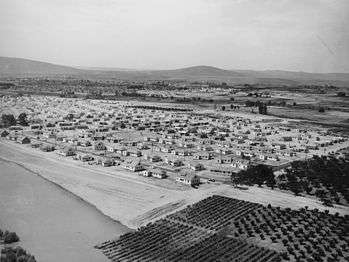
Richland was a small farm town until the US Army purchased 640 sq mi (1,660 km2) of land – half the size of Rhode Island – along the Columbia River during World War II, evicting the 300 residents of Richland as well as those of the now vanished towns of White Bluffs and Hanford just upriver. The army turned it into a bedroom community for the workers on its Manhattan Project facility at the nearby Hanford Engineering Works (now the Hanford site). The population increased from 300 in July and August 1943 to 25,000 by the end of World War II in August 1945. All land and buildings were owned by the government. Housing was assigned to residents and token rent was collected; families were assigned to houses or duplexes; single people were placed in apartments or barracks. Everything necessary was provided, from free bus service to light bulbs, and trees were planted in people's yards by the government. In 1954 Harold Orlando Monson was elected the first mayor of Richland and traveled to Washington, D.C., to negotiate increased rights (such as private home ownership) for citizens in military cities across the country.
As much of the city was planned by the Army Corps of Engineers, many of the streets are named after famous engineers. For instance, the main street (George Washington Way) is named after the first president, who was a surveyor; Stevens Drive is named after John Frank Stevens, chief engineer of the Panama Canal and Stevens Pass; Goethals Drive is named after George W. Goethals, designer of the Panama Canal; and Thayer Drive is named after Sylvanus Thayer, founder of the first professional school of engineering in the United States at Dartmouth College. The rule is that if alphabet houses reside on a given street, it is named either after an engineer or a type of tree. Due to the unique history of the area, it was added to the National Register of Historic Places in 2005 as the Gold Coast Historic District.
The end of the war
With the end of the war, the Hanford workers camp, originally located fifteen miles (24 km) north of Richland at the old Hanford town site, was closed down. Although many of the workers moved away as the war effort wound down, some of them moved to Richland, offsetting the depopulation that might otherwise have occurred.
The Cold War boom
Fears that the Soviet Union's intentions were aggressive set off the Cold War in 1947. The capacity to produce plutonium was increased beginning in 1947. When the Soviet Union developed and tested their first nuclear weapon in 1949, the U.S. nuclear program was reinvigorated. A second post-WW II expansion began in 1950 as a result of the war in Korea. Richland's Cold War construction boom resulted in Richland's population growing to 27,000 people by 1952. Many of these people lived in a construction camp of trailers located in what is now north Richland. With time, these trailers were vacated and the core city grew. Others lived at Camp Columbia near Horn Rapids until the camp was closed in 1950.
Transition to private property
The government got out of the landlord business in 1957 when the real estate was sold to the residents. Most of the people lived in duplexes; senior tenants were given the option to purchase the building; junior tenants were given the option to purchase lots in a newly platted area of north Richland. Richland was incorporated in 1958 as a chartered First Class City, an open self-governed city. As part of the transition, large areas of undeveloped land became city property. Richland's financial dependency on the federal Hanford facility changed little at this time because Hanford's mission as a weapons materials production site continued during the Cold War years.
Unclassified Hanford
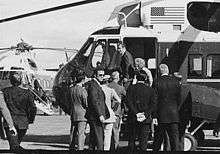
At some point, documents and photographs of the Hanford military facilities became declassified by the US government. Those digitized records are considered to be in the public domain, and hosted on a website named the Hanover Document Retrieval System.[7]
Historical events, such as a visit to the property by President Richard Nixon, are also stored on the database.
After the production boom
With the shutdown of the last production reactor in 1987, the area transitioned to environmental cleanup and technology. Now, many Richland residents are employed at the Hanford site in its environmental cleanup mission.
Richland High School's sports teams are called the Bombers, complete with a mushroom cloud logo. Some of the streets platted after 1958 are named after U.S. Army generals (Patton Street, MacArthur Street, Sherman Street, Pershing Avenue) and after various nuclear themes (Einstein Avenue, Curie Street, Proton Lane, Log Lane, and Nuclear Lane). A local museum, the Columbia River Exhibition of History, Science, and Technology, features exhibits of nuclear technology.
Washington State University, Tri-Cities was founded in northern Richland in 1989, growing out of a former Joint Graduate Center which had been affiliated with the University of Washington, Oregon State University, and Washington State University. Richland is also home to Kadlec Regional Medical Center. Columbia Basin College's Medical Training Center is near Kadlec Regional Medical Center.
City of Richland services
The city of Richland is a full-service city providing police services, fire protection, water waste services, electric utilities, parks and recreational facilities and services, maintenance of city streets and public facilities, and full library services featuring a state of the art library operated by the city. The city also pursues community and economic development and offers housing assistance.
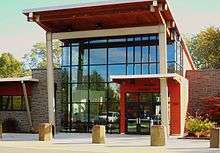
The Richland Community Center is adjacent to Howard Amon Park, on the east side of the Columbia River. The building was designed by ARC Architects of Seattle, Washington.
It has views of the park and Columbia River from many of the rooms, which make it a popular venue for weddings and receptions, family reunions, birthday parties, business, and community meetings. The rooms are also used for a variety of general education and personal enrichment classes including courses in computer/technology, health & fitness, dance, art & crafts, dog training, home & gardening, language lessons, martial arts, and many more. The Community Center also serves as a gathering place for group recreation and gaming: cribbage, pinochle, bridge, pool, dominoes, and a host of other social activities are available to the public at large.
More recently, the Richland Community Center has hosted a number of important civic events including the Green Living Awards and the Fall Carnival.[8]
As of 2016 the city was planning rebuild its current city hall to across Jadwin Ave into the parking lot of the Unites States Federal courthouse. This decisions also includes moving the fire station which is currently across George Washington Way to the current site of city hall and they would sell the current city hall to eligible businesses.[9]
Police services
The City of Richland Police Department comprises approximately 58 commissioned police officers and approximately 15 support staff.[10]
Economy
Technology
After the end of World War II Richland continued to be a center of production and research into nuclear energy, and related technology.
It has been the home of Pacific Northwest National Laboratory (PNNL) since 1965. One of the two Laser Interferometer Gravitational-Wave Observatory sites is located immediately north of Richland. Numerous smaller high technology business and expert consultants have grown up around the Richland technology center as well.
Major employers include Battelle Memorial Institute operating PNNL, Bechtel National Inc. building a waste vitrification plant, Washington River Protection Solutions (a partnership of AECOM and EnergySolutions) controlling operations of the nuclear waste tank farms, Washington Closure Hanford (a partnership of AECOM, Bechtel, and CH2M Hill) providing waste management and cleanup efforts including decontamination and demolition (D&D) of facilities along the Columbia River, Mission Support Alliance (a partnership of Lockheed Martin, Jacobs Engineering Group, and Centerra Group) providing infrastructure and sitewide services, CH2M Hill Plateau Remediation Company responsible for D&D of facilities on the site's Central Plateau, EnergySolutions providing services to the U.S. government, Energy Northwest generating nuclear power at a nearby reactor facility, Areva creating nuclear fuel, Lockheed Martin Services, Inc. providing technology services and the U.S. Department of Energy which operates the Hanford Site.
Agriculture
Agriculture is important in the Richland area; the Tri-Cities area of the Columbia Basin grows excellent produce. Richland hosts an important food processor, ConAgra/Lamb-Weston, which processes potatoes and other foods.
The production of wine in the lower Columbia Basin has become one of the main industries. Richland lies at the center of a flourishing viticulture area which produces internationally recognized wines in four major Washington appellations and serves as an ideal center for wine tours. The Columbia Valley appellation which surrounds Richland contains over 7,000 hectares planted to wine grapes. On the west the Yakima Valley appellation includes 5,000 hectares. To the east, the Walla Walla Valley appellation includes 500 hectares of wine grapes.
Business and industry
The Tri-City Industrial Development Council promotes both agricultural related and technology related industries in the region.
Top employers
According to Richland's 2014 Comprehensive Annual Financial Report,[11] the top employers in the city are:
| # | Employer | # of Employees |
|---|---|---|
| 1 | Pacific Northwest National Laboratory | 3,239 |
| 2 | Kadlec Regional Medical Center | 2,754 |
| 3 | Bechtel | 2,006 |
| 4 | Washington River Protection Solutions | 1,518 |
| 5 | Mission Support Alliance | 1484 |
| 6 | Richland School District | 1,400 |
| 7 | Energy Northwest | 1,174 |
| 8 | Areva | 1,048 |
| 9 | Washington Closure Hanford | 815 |
| 10 | City of Richland | 485 |
Education
The Richland School District serves the cities of Richland and West Richland with nine elementary schools, three middle schools, and four high schools.
Columbia Basin College, primarily located in Pasco, has a small branch campus in Richland.
Washington State University, Tri-Cities, established in North Richland in 1989, sits on the western bank of the Columbia River. The university offers a number of undergraduate and graduate degree programs; it first admitted freshmen and sophomores in the fall of 2007.
Recreation
Golf

Richland's climate makes golf one of the most popular sports. Three 18 hole courses and one 9 hole course designed for varying levels of skill are available in Richland.
Outdoor activities
Richland has developed a number of parks, several of them fronting on the Columbia and Yakima Rivers. The rivers provide boating, water skiing, fishing, kayaking and waterfowl hunting opportunities for the outdoor enthusiast.
Richland is included in a bike trail system in the Tri Cities which is named The Sacagawea Heritage Trail. The trail is a scenic river ride along the Columbia River through the Tri Cities of Kennewick, Richland and Pasco. It is a 23-mile multipurpose blacktop loop trail on both sides of the river from Sacagawea State Park at the confluence of the Snake and Columbia Rivers up to the I-182 bridge at the Columbia Point Marina on the upper end. Three bridges join the trails on both sides, providing a number of ride options. There are numerous trailheads and access parking spots along the route.
Richland lies within a semi-arid, shrub-steppe environment, and has a number of interesting natural areas within or adjacent to the city:
- The Yakima River delta and wetlands lie within Richland and provide habitat for many birds and animals. The area around the Yakima delta provides a wooded variation of the normal shrub-steppe.
- The Badger Mountain Centennial Preserve protects Badger Mountain, located on the edge of Richland in the Richland GMA area, provides a spectacular view of the Tri-Cities as well as the Columbia and Yakima rivers. A non-profit group, Friends of Badger Mountain, worked to procure this shrub-steppe area that has most native vegetation intact and then in 2005 built a trail to the summit so others can enjoy it. The 2-kilometer trail rises 300 meters above the trailhead in Richland.
- The Arid Lands Ecology Reserve, at the western edge of Richland on the Hanford Reservation, is the last remaining large block of undisturbed shrub-steppe habitat in the Pacific Northwest. The site has been closed to public since the 1940s, preserving its character. It is managed as an environmental research area and wildlife reserve.
- North of Richland, the Hanford Reach, the last free-flowing stretch of the Columbia River in the U.S., provides both excellent sightseeing and superior salmon fishing. This free-flowing stretch flows through the Hanford Reach National Monument, which was created by Presidential proclamation in 2000, is managed by the U.S. Fish and Wildlife Service. Volunteers are working to construct an interpretive center on Richland's Columbia Point at the confluence of the Yakima a Columbia; as of January 2006, $22M of the necessary funds are in hand and construction is expected later in the year.
- The Amon Creek Natural Preserve in the south part of town protects wetlands around the creek and has several trails.
Sports
Two notable sports teams are found in the immediate area:
- The Tri-City Americans WHL ice hockey team plays in Kennewick.
- The Tri-City Dust Devils Single-A baseball team (affiliated with the San Diego Padres) plays in Pasco.
Geography
Richland is located at 46°16′47″N 119°16′53″W / 46.27972°N 119.28139°W (46.279657, -119.281377).[12]
According to the United States Census Bureau, the city has a total area of 39.11 square miles (101.29 km2), of which, 35.72 square miles (92.51 km2) is land and 3.39 square miles (8.78 km2) is water.[1] Elevation at the airport is 120 m (394 ft).
Climate
Richland receives about 7 inches (180 mm) of precipitation per year giving it a semi-arid desert climate and resulting in a shrub-steppe environment. Summers are hot with infrequent thunderstorms, while winters are milder than all of Eastern Washington with snow falling only occasionally .
| Climate data for Richland, Washington | |||||||||||||
|---|---|---|---|---|---|---|---|---|---|---|---|---|---|
| Month | Jan | Feb | Mar | Apr | May | Jun | Jul | Aug | Sep | Oct | Nov | Dec | Year |
| Record high °F (°C) | 71 (22) |
73 (23) |
82 (28) |
92 (33) |
105 (41) |
110 (43) |
110 (43) |
113 (45) |
106 (41) |
89 (32) |
77 (25) |
66 (19) |
113 (45) |
| Mean maximum °F (°C) | 58.3 (14.6) |
62.71 (17.06) |
71.0 (21.7) |
81.2 (27.3) |
91. (33) |
97.0 (36.1) |
102.9 (39.4) |
101.3 (38.5) |
93.5 (34.2) |
80.8 (27.1) |
66.2 (19) |
58.7 (14.8) |
104.0 (40) |
| Average high °F (°C) | 40.7 (4.8) |
48.6 (9.2) |
57.9 (14.4) |
66.4 (19.1) |
75.3 (24.1) |
82.2 (27.9) |
90.5 (32.5) |
89.3 (31.8) |
80.6 (27) |
66.7 (19.3) |
50.7 (10.4) |
41.5 (5.3) |
65.87 (18.82) |
| Average low °F (°C) | 26.4 (−3.1) |
30.2 (−1) |
35.1 (1.7) |
40.8 (4.9) |
48.1 (8.9) |
54.7 (12.6) |
59.7 (15.4) |
58.7 (14.8) |
50.8 (10.4) |
41.2 (5.1) |
33.7 (0.9) |
28.2 (−2.1) |
42.3 (5.71) |
| Mean minimum °F (°C) | 1.0 (−17.2) |
15.4 (−9.2) |
23.4 (−4.8) |
30.0 (−1.1) |
37.4 (3) |
45.4 (7.4) |
50.2 (10.1) |
49.6 (9.8) |
39.2 (4) |
28.5 (−1.9) |
19.1 (−7.2) |
13.0 (−10.6) |
1.0 (−17.2) |
| Record low °F (°C) | −21 (−29) |
−22 (−30) |
11 (−12) |
23 (−5) |
30 (−1) |
38 (3) |
41 (5) |
39 (4) |
31 (−1) |
13 (−11) |
−6 (−21) |
−10 (−23) |
−22 (−30) |
| Average precipitation inches (mm) | 0.99 (25.1) |
0.70 (17.8) |
0.61 (15.5) |
0.49 (12.4) |
0.59 (15) |
0.54 (13.7) |
0.20 (5.1) |
0.23 (5.8) |
0.28 (7.1) |
0.54 (13.7) |
0.98 (24.9) |
1.05 (26.7) |
7.1 (180) |
| Average snowfall inches (cm) | 2.6 (6.6) |
1.5 (3.8) |
0.3 (0.8) |
0.0 (0) |
0.0 (0) |
0.0 (0) |
0.0 (0) |
0.0 (0) |
0.0 (0) |
trace | 0.6 (1.5) |
2.2 (5.6) |
7.1 (18) |
| Source: [13] | |||||||||||||
Demographics
| Historical population | |||
|---|---|---|---|
| Census | Pop. | %± | |
| 1910 | 350 | — | |
| 1920 | 279 | −20.3% | |
| 1930 | 208 | −25.4% | |
| 1940 | 247 | 18.8% | |
| 1950 | 21,809 | 8,729.6% | |
| 1960 | 23,548 | 8.0% | |
| 1970 | 26,290 | 11.6% | |
| 1980 | 33,578 | 27.7% | |
| 1990 | 32,315 | −3.8% | |
| 2000 | 38,708 | 19.8% | |
| 2010 | 48,058 | 24.2% | |
| Est. 2015 | 54,248 | [14] | 12.9% |
| source:[15] 2015 Estimate[3] | |||
Based on per capita income, one of the more reliable measures of affluence, Richland ranks 83rd of 522 areas ranked in the state of Washington—the highest rank achieved in Benton County.
2010 census
As of the census[2] of 2010, there were 48,058 people, 19,707 households, and 12,974 families residing in the city. The population density was 1,345.4 inhabitants per square mile (519.5/km2). There were 20,876 housing units at an average density of 584.4 per square mile (225.6/km2). The racial makeup of the city was 87.0% White, 1.4% African American, 0.8% Native American, 4.7% Asian, 0.1% Pacific Islander, 2.7% from other races, and 3.2% from two or more races. Hispanic or Latino of any race were 7.8% of the population.
There were 19,707 households of which 31.0% had children under the age of 18 living with them, 51.6% were married couples living together, 10.0% had a female householder with no husband present, 4.2% had a male householder with no wife present, and 34.2% were non-families. 28.2% of all households were made up of individuals and 10.1% had someone living alone who was 65 years of age or older. The average household size was 2.42 and the average family size was 2.97.
The median age in the city was 39.4 years. 24.2% of residents were under the age of 18; 8.1% were between the ages of 18 and 24; 24.7% were from 25 to 44; 28.4% were from 45 to 64; and 14.6% were 65 years of age or older. The gender makeup of the city was 49.0% male and 51.0% female.
2000 census
As of the 2000 census, there were 38,708 people, 15,549 households, and 10,682 families residing in the city. The population density was 1,111.8 people per square mile (429.2/km²). There were 16,458 housing units at an average density of 472.7 per square mile (182.5/km²). The racial makeup of the city was 89.55% White, 1.37% African American, 0.76% Native American, 4.06% Asian, 0.11% Pacific Islander, 1.85% from other races, and 2.31% from two or more races. Hispanic or Latino of any race was 4.72% of the population.
There were 15,549 households out of which 34.1% had children under the age of 18 living with them, 56% were married couples living together, 9.3% had a female householder with no husband present, and 31.3% were non-families. 27.2% of all households were made up of individuals and 9.4% had someone living alone who was 65 years of age or older. The average household size was 2.48 and the average family size was 3.02.
In the city the population was spread out with 27.2% under the age of 18, 7.5% from 18 to 24, 27.1% from 25 to 44, 25.4% from 45 to 64, and 12.8% who were 65 years of age or older. The median age was 38 years. For every 100 females, there were 96 males. For every 100 females age 18 and over, there were 93.2 males.
The median income for a household in the city was $53,092, and the median income for a family was $82,354 (Money CNN). Males had a median income of $52,648 versus $30,472 for females. The per capita income for the city was $25,494. About 5.7% of families and 8.2% of the population were below the poverty line, including 10.8% of those under age 18 and 5.6% of those age 65 or over.
Transportation
Richland is served by Richland Airport, located in the city, as well as the Tri-Cities Airport, located in nearby Pasco. Both have only domestic flights.
Ben Franklin Transit provides bus transportation within Richland and the Tri Cities area.
Notable people
- James (Jim) F. Albaugh - Executive Vice President, The Boeing Company, RHS class of 1968
- Stu Barnes - NHL former player and coach who lives in Richland and now is an owner of the Tri-City Americans along with Olaf Kolzig
- Tyler Brayton - National Football League defensive end for the Carolina Panthers
- Travis Buck - San Diego Padres outfielder
- Orson Scott Card - Science fiction writer (born in Richland but his family moved away soon after)
- Larry Coryell - Jazz guitarist, RHS class of 1961
- Gene Conley - Major League Basketball and Baseball player, RHS
- Westley Allan Dodd - Serial killer and child molester, RHS class of 1979, hanged January 5, 1993
- Santino Fontana - Nominated for the 2013 Tony Award for Best Leading Actor in Musical for his role in the revival of "Cinderella"
- Kurt Kafentzis - former NFL defensive back
- Mark Kafentzis - former NFL defensive back
- Olaf Kolzig - Retired NHL goaltender who lives in Richland and now owns the Tri-City Americans (along with Stu Barnes)
- Dina Washburn Kruger - Nobel Peace Prize participant 2007, member of the Intergovernmental Panel on Climate Change, director of the U.S. EPA climate change division, Hanford High class of 1980
- James N. Mattis - General, United States Marine Corps RHS class of 1968
- Mike McCormack - U.S. Representative from Fourth Congressional District
- Jimmy McLarnin - Irish boxer, two-time welterweight world champion and an International Boxing Hall of Fame inductee.
- Nate Mendel - Sunny Day Real Estate and Foo Fighters bassist Hanford High School Class of 1987
- Keith A. Moore - Nerdcore artist known as Beefy
- Jason Repko - Major League Baseball outfielder; Hanford High class of 1999
- Kathryn Ruemmler - White House Counsel to President Barack Obama, RHS class of 1989
- Hope Solo - United States women's national soccer team goalkeeper, Summer Olympic Gold Medalist, FIFA Women's World Cup champion, RHS class of 1999
- Sharon Tate - Actress, murder victim of Charles Manson followers, Miss Richland, 1959
- John Archibald Wheeler - eminent American theoretical physicist
Sister city
See also
- Hanford High School
- Pacific Northwest National Laboratory
- Hanford Site
- Richland High School
- Richland School District
- Washington State University, Tri-Cities
- Ben Franklin Transit
- Kate Brown
Footnotes
- 1 2 "US Gazetteer files 2010". United States Census Bureau. Archived from the original on January 24, 2012. Retrieved 2012-12-19.
- 1 2 "American FactFinder". United States Census Bureau. Retrieved 2012-12-19.
- 1 2 "Population Estimates". United States Census Bureau. Retrieved June 15, 2016.
- ↑ "US Board on Geographic Names". United States Geological Survey. 2007-10-25. Retrieved 2008-01-31.
- ↑ "April 1, 2013 Population of Cities, Towns and Counties Used for Allocation of Selected State Revenues State of Washington" (PDF). Washington State Office of Financial Management (web site). 2013-09-18. Retrieved 2012-08-25.
- ↑ Meany, Edmond S. (1923). Origin of Washington geographic names. Seattle: University of Washington Press. p. 244.
- ↑ "Hanford.gov".
- ↑ Herald, Tri-City (September 28, 2013). "Community Center to Hold Green". Tri-City Heral.
- ↑ City website, Richland (April 4, 2016). "Swift Corridor and Future City Hall".
- ↑ http://www.tri-cityherald.com/2013/01/19/2242016/richland-police-department-honors.html
- ↑ City of Richland CAFR
- ↑ "US Gazetteer files: 2010, 2000, and 1990". United States Census Bureau. 2011-02-12. Retrieved 2011-04-23.
- ↑ "RICHLAND, WASHINGTON (457015)". Western Regional Climate Center. Retrieved April 25, 2016.
- ↑ "Annual Estimates of the Resident Population for Incorporated Places: April 1, 2010 to July 1, 2015". Retrieved July 2, 2016.
- ↑ Moffatt, Riley. Population History of Western U.S. Cities & Towns, 1850-1990. Lanham: Scarecrow, 1996, 331.
- ↑ United States Census Bureau. "Census of Population and Housing". Archived from the original on May 11, 2015. Retrieved September 19, 2013.
Further reading
- Kate Brown, Plutopia: Nuclear Families, Atomic Cities, and the Great Soviet and American Plutonium Disasters. New York: Oxford University Press, 2013.
- Barbara J. Kubik, Richland, Celebrating Its Heritage. Richland, WA: City of Richland, Washington, 1994.
- Paul Loeb, Nuclear Culture: Living & Working in the World's Largest Atomic Complex. Philadelphia, PA: New Society Publishers, 1986.
- Christine F. Noonan, Federal City Revisited: Atomic Energy and Community Identify in Richland, Washington. PhD dissertation. Ball State University, 2000.
- S.L. Sanger, Hanford and the Bomb: An Oral History of World War II. Seattle, WA: Living History Press, 1989.
External links
| Wikimedia Commons has media related to Richland, Washington. |
| Wikivoyage has a travel guide for Richland. |
- Hanford Reach National Monument
- Plutopia: Nuclear Families, Atomic Cities, and the Great Soviet and American Plutonium Disasters
